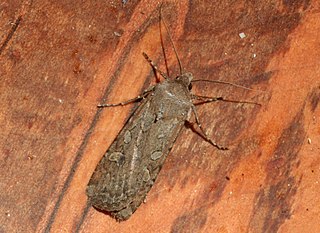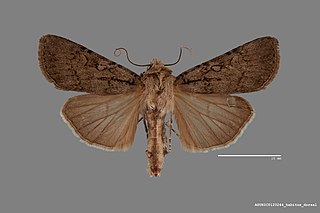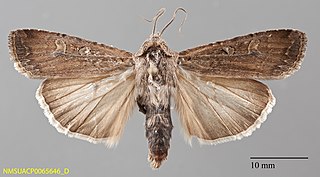
The army cutworm is the immature form of Euxoa auxiliaris. The adult moth is called a "miller moth" because of the fine scales on its wings that rub off easily and remind people of the dusty flour that covers the clothing of a miller.

Euxoa is a genus of moths of the family Noctuidae raised to Genus by the German entomologist, Jacob Hübner. The Genus is mostly confined to dry and semi dry areas in the Northern Hemisphere. There 130 species in Eurasia, a few in Africa, and 175 in North America. There are no species in the Genus in South-East Asia or in Australia. In North America, most species are found in Western regions. Of the North American species, 4 are endemic to Mexico. There is one species recorded from Chile, but this may be a mislabeled specimen. In real terms, species numbers do not equal species abundance. Some areas with few species have large numbers of the ones that do live there.

Euxoa catenula is a species of moth of the family Noctuidae first described by Augustus Radcliffe Grote in 1879. It is found in North America from southern Saskatchewan west to southern Vancouver Island, south to Kansas, New Mexico, Arizona and southern California.
Euxoa bochus is a moth of the family Noctuidae first described by Herbert Knowles Morrison in 1874. It is found in western North America, from Vancouver Island, south to southern Utah and northern New Mexico, east to central Colorado, Wyoming and the Cypress Hills area of south-western Saskatchewan. It is also present in Manitoba and British Columbia.
Euxoa declarata, the clear dart, is a moth of the family Noctuidae. The species was first described by Francis Walker in 1865. It is found in Canada in Ontario, Quebec, New Brunswick, Nova Scotia, Prince Edward Island, British Columbia, Alberta, Saskatchewan, Yukon and Manitoba. It is found as far west as central Alaska. In the United States it is also found to Minnesota and North Carolina in the east and Arizona, New Mexico and California in the west.
Euxoa aequalis is a moth of the family Noctuidae first described by Leon F. Harvey in 1876. It is found in Canada from British Columbia, Alberta, Saskatchewan and Yukon, south into the United States, where it has been recorded from Colorado, Wyoming and California.

Euxoa albipennis is a moth of the family Noctuidae first described by Augustus Radcliffe Grote in 1876. It is found from coast to coast in southern Canada and the northern parts of the United States, ranging southward in the west to New Mexico, Arizona and California.

Euxoa choris is a moth of the family Noctuidae first described by Leon F. Harvey in 1876. It is found in North America from south-western Saskatchewan, central Alberta and south-central Yukon, south to New Mexico, Arizona and California.

Euxoa comosa, the hairy euxoa moth, is a moth of the family Noctuidae first described by Herbert Knowles Morrison in 1876. It is found in western North America, except the Pacific coast, ranging east through the northern Great Plains, and in the Hudsonian zone to the Atlantic Ocean. It is found in every province and territory of Canada, except Nunavut.
Noctuini is a tribe of owlet moths in the family Noctuidae. There are at least 520 described species in Noctuini.
Euxoa violaris, the violet dart moth, is a species of moth native to North America. It is listed as a species of special concern in the US state of Connecticut. It was described by Augustus Radcliffe Grote and Coleman Townsend Robinson in 1868.
Euxoa oberfoelli, or Oberfoell's dart moth, is a species of cutworm or dart moth in the family Noctuidae. It is found in North America.
Chrysocraspeda tristicula is a moth of the family Geometridae first described by Swinhoe in 1885. It is found in Sri Lanka. India, Myanmar, Borneo, Philippines and Sumbawa.

Euxoa inconcinna is a species of cutworm or dart moth in the family Noctuidae. It is found in North America.
Euxoa lillooet is a species of cutworm or dart moth in the family Noctuidae. It is found in North America.
Euxoa cinnabarina is a species of cutworm or dart moth in the family Noctuidae first described by William Barnes and James Halliday McDunnough in 1918. It is found in North America.
Euxoa xasta is a species of cutworm or dart moth in the family Noctuidae first described by William Barnes and James Halliday McDunnough in 1910. It is found in North America.
Euxoa latro is a species of cutworm or dart moth in the family Noctuidae first described by William Barnes and Foster Hendrickson Benjamin in 1927. It is found in North America.






